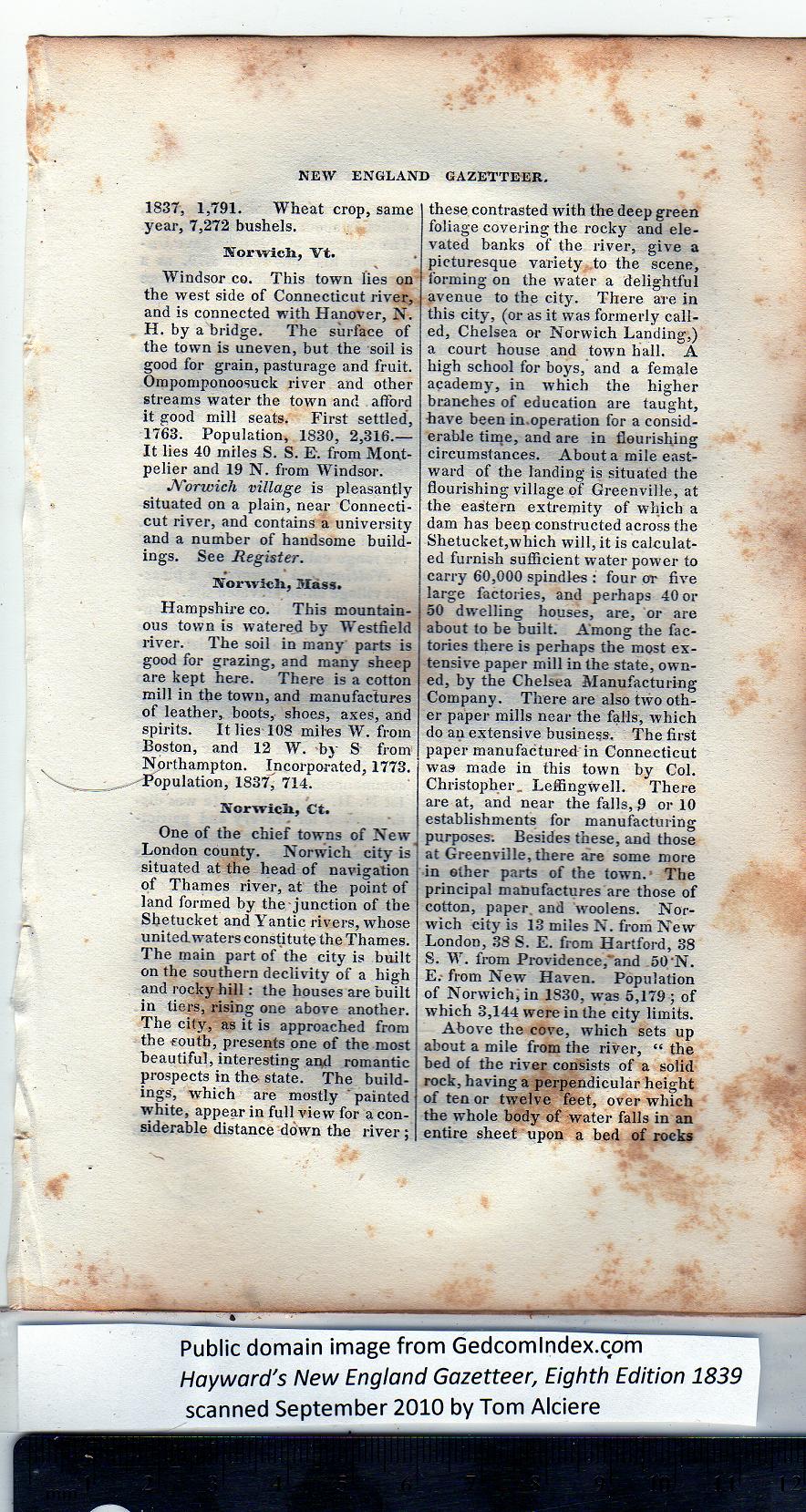|
1837, 1,791. Wheat crop, same
year, 7,272 bushels.
Norwich, Vt.
Windsor co. This town lies on
the west side of Connecticut river,,
and is connected with Hanover, N.
H. by a bridge. The surface of
the town is uneven, but the soil is
good for grain, pasturage and fruit.
Ompomponoosuck river and other
streams water the town and afford
it good mill seats. First settled,
1763. Population, 1830, 2,316.—
It lies 40 miles S. S. E. from Mont-
pelier and 19 N. from Windsor.
Norwich village is pleasantly
situated on a plain, near Connecti-
cut river, and contains a university
and a number of handsome build-
ings. See Register.
Norwich, Mass.
Hampshire co. This mountain-
ous town is watered by Westfield
river. The soil in many parts is
good for grazing, and many sheep
are kept here. There is a cotton
mill in the town, and manufactures
of leather, boots, shoes, axes, and
spirits. It lies 108 miles W. from
Boston, and 12 W. by S from
Northampton. Incorporated, 1773.
Population, 1837, 714.
Norwich, Ct. |
One of the chief towns of New
London county. Norwich city is
situated at the head of navigation
of Thames river, at the point of
land formed by the junction of the
Sbetucket and Yantic rivers, whose
unitedwaters constitute the Thames.
The main part of the city is built
on the southern declivity of a high
and rocky hill: the houses are built
in tiers, rising one above another.
The city, as it is approached from
the eouth, presents one of the most
beautiful, interesting and romantic
prospects in the state. The build-
ings, which are mostly ' painted
white, appear in full view for a con-
siderable distance down the river j
these contrasted with the deep green
foliage covering the rocky and ele-
vated banks of the river, give a
picturesque variety to the scene,
forming on the water a delightful
avenue to the city. There are in
this city, (or as it was formerly call-
ed, Chelsea or Norwich Landing,)
a court house and town hall. A
high school for boys, and a female
academy, in which the higher
branches of education are taught,
have been in.operation for a consid-
erable time, and are in flourishing
circumstances. About a mile east-
ward of the landing is situated the
flourishing village of Greenville, at
the eastern extremity of which a
dam has been constructed across the
Shetucket,which will, it is calculat-
ed furnish sufficient water power to
carry 60,000 spindles : four or five
large factories, and perhaps 40 or
50 dwelling houses, are, or are
about to be built. Among the fac-
tories there is perhaps the most ex-
tensive paper mill in the state, own-
ed, by the Chelsea Manufacturing
Company. There are also two oth-
er paper mills near the falls, which
do an extensive business. The first
paper manufactured in Connecticut
was made in this town by Col.
Christopher. Leffingwell. There
are at, and near the falls, 9 or 10
establishments for manufacturing
purposes. Besides these, and those
at Greenville, there are some more
in ether parts of the town. The
principal manufactures are those of
cotton, paper and woolens. Nor-
wich city is 13 miles N. from New
London, 38 S. E. from Hartford, 38
S. W. from Providence,"and 50 *N.
E. from New Haven. Population
of Norwich, in 1830, was 5,179 ; of
which 3,144 were in the city limits.
Above the cove, which sets up
about a mile from the river, “ the
bed of the river consists of a solid
rock, having a perpendicular height
of tenor twelve feet, over which
the whole body of water falls in an
entire sheet upon a bed of rocks |
